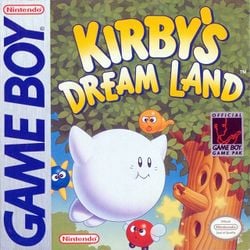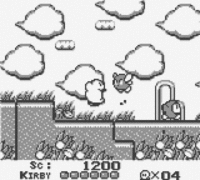Kirby's Dream Land: Difference between revisions
(→Legacy) |
m (Added a missing period in one of the very first sentences.) |
||
| (45 intermediate revisions by 28 users not shown) | |||
| Line 1: | Line 1: | ||
{{Title|''Kirby's Dream Land''}} | |||
{{ArticleIcons|allgames=y}} | |||
{{Infobox Game | {{Infobox Game | ||
| title | |title = Kirby's Dream Land | ||
| image | |image = [[File:Kirby'sDreamLand.jpg|250px]] | ||
| caption | |caption =[[File:KirbySymbol.svg|50px|class=invert]] | ||
| developer | |developer = [[HAL Laboratory]] | ||
| publisher | |publisher = [[Nintendo]] | ||
|designer = [[Masahiro Sakurai]] | |||
| designer | |released = {{Flag|Japan}} April 27, 1992<br>{{Flag|United States}} August 1, 1992<br>{{Flag|Europe}} August 3, 1992 | ||
|genre = Platformer | |||
|platform = Game Boy<br>Virtual Console | |||
| released | |interwiki = wikirby | ||
| genre | |interwikiname = WiKirby | ||
|interwikipage = Kirby's Dream Land | |||
| | |||
| | |||
| | |||
| | |||
}} | }} | ||
'''''Kirby's Dream Land''''' ({{ja|星のカービィ}}, '' | '''''Kirby's Dream Land''''' ({{ja|星のカービィ|Hoshi no Kābī}}, ''Kirby of the Stars'') is a 1992 platforming game developed by [[HAL Laboratory]] for the [[Nintendo]] Game Boy. It is the first game in the {{uv|Kirby}} series, and thus the debut game of [[Kirby]]. It is featured as a [[Masterpiece]] in {{forwiiu}}. | ||
'' | ==In the ''{{b|Super Smash Bros.|series}}'' series== | ||
[[File:KirbysDreamLand.gif|thumb|left|Kirby using his signature {{b|Inhale|Kirby}}, both of which made their debut in ''Kirby's Dream Land''.]] | |||
===Fighters=== | |||
Kirby and [[King Dedede]] both debuted in this game. | |||
== | ===Moves=== | ||
Kirby's {{b|Inhale|Kirby}} and Star Spit attack come from this game. King Dedede's [[dash attack]], [[forward smash]], [[Inhale (King Dedede)|Inhale]], and [[Super Dedede Jump]] come from this game. | |||
===Stages=== | |||
[[Dream Land (SSB)|Dream Land]] in [[Super Smash Bros.|SSB]] and [[Green Greens]] are both based off of the first level in the game, Green Greens. [[Dream Land GB]] in ''SSB4'' and ''[[Ultimate]]'' is based off of various levels in the game. | |||
===Items=== | |||
[[Warp Star]]s are used to get to new areas in the game. The [[Apple]]s from the Green Greens stage in ''Melee'' are also used to defeat [[Whispy Woods]], the first boss of the game. The [[Superspicy Curry]] appears as an item in ''[[Super Smash Bros. Brawl]]'' and ''[[Super Smash Bros. for Nintendo 3DS / Wii U]]''. Also, the [[Maxim Tomato]] appears as an item in all games, though never healing all damage as it does in the Kirby series. | |||
'' | ===Enemies=== | ||
[[Waddle Dee]], [[Parasol Waddle Dee]], [[Waddle Doo]], [[Gordo]], [[Bronto Burt]] and [[Shotzo]] all appear as enemies in [[Smash Run]] in ''[[Super Smash Bros. for Nintendo 3DS]]''. Whispy Woods appear on the stages Dream Land in ''[[Super Smash Bros.]]'', ''[[Super Smash Bros. Melee]]'' and ''Super Smash Bros. for Nintendo 3DS/ Wii U'', and Green Greens in ''Super Smash Bros. Melee'' and ''Super Smash Bros. Brawl''. | |||
=='' | ===Music=== | ||
{{ | Songs from ''Kirby's Dream Land'' include {{MeleeMusic|Green Greens}} from ''Melee'' and {{SSB4MusicLink|Kirby|Green Greens Ver. 2}} from ''Smash 4'', two different orchestral renditions of the music for the game's opening stage of the same name; {{SSBBMusicLink|Kirby|King Dedede's Theme}} from ''Brawl'' and {{SSB4MusicLink|Kirby|King Dedede's Theme Ver. 2}} from ''Smash 4'', two arrangements of the music that plays at Mt. Dedede and when battling King Dedede; {{SSB4MusicLink|Kirby|Green Greens}}, {{SSB4MusicLink|Kirby|Castle Lololo}}, {{SSB4MusicLink|Kirby|Float Islands}}, {{SSB4MusicLink|Kirby|Bubbly Clouds}}, and {{SSB4MusicLink|Kirby|Mt. Dedede}}, the original Game Boy versions of all the game's stage themes, which in Super Smash Bros. Ultimate were compiled into the {{SSBUMusicLink|Kirby|Kirby Retro Medley}}; and {{SSBUMusicLink|Kirby|Staff Credits - Kirby's Dream Land}} from ''Smash Ultimate'', an arrangement of the game's credits theme along with that of [[Kirby Super Star]]. | ||
Kirby | |||
===Miscellaneous=== | |||
Kirby and King Dedede's gray alternate costumes are based on how they appeared in this game. Kirby's up [[taunt]] is the Kirby Dance, which first appeared in this game. His [[victory pose]]s are also variations of the Kirby Dance. Additionally, Kirby and King Dedede's [[victory theme]]s are a cover of the "Level Completed" music. [[Meta Knight]] has the same victory theme, but it is played in heavy-metal and in electric guitars. | |||
{{SSB4Masterpieces}} | |||
{{Kirby universe}} | |||
[[Category:Games]] | [[Category:Games]] | ||
[[Category:Kirby universe]] | [[Category:Kirby universe]] | ||
[[Category:Masterpieces]] | |||
Latest revision as of 22:03, November 18, 2023
| Kirby's Dream Land | |
|---|---|
 
| |
| Developer(s) | HAL Laboratory |
| Publisher(s) | Nintendo |
| Designer(s) | Masahiro Sakurai |
| Released | |
| Genre(s) | Platformer |
| Platform(s) | Game Boy Virtual Console |
| Article on WiKirby | Kirby's Dream Land |
Kirby's Dream Land (星のカービィ, Kirby of the Stars) is a 1992 platforming game developed by HAL Laboratory for the Nintendo Game Boy. It is the first game in the Kirby series, and thus the debut game of Kirby. It is featured as a Masterpiece in Super Smash Bros. for Wii U.
In the Super Smash Bros. series[edit]

Fighters[edit]
Kirby and King Dedede both debuted in this game.
Moves[edit]
Kirby's Inhale and Star Spit attack come from this game. King Dedede's dash attack, forward smash, Inhale, and Super Dedede Jump come from this game.
Stages[edit]
Dream Land in SSB and Green Greens are both based off of the first level in the game, Green Greens. Dream Land GB in SSB4 and Ultimate is based off of various levels in the game.
Items[edit]
Warp Stars are used to get to new areas in the game. The Apples from the Green Greens stage in Melee are also used to defeat Whispy Woods, the first boss of the game. The Superspicy Curry appears as an item in Super Smash Bros. Brawl and Super Smash Bros. for Nintendo 3DS / Wii U. Also, the Maxim Tomato appears as an item in all games, though never healing all damage as it does in the Kirby series.
Enemies[edit]
Waddle Dee, Parasol Waddle Dee, Waddle Doo, Gordo, Bronto Burt and Shotzo all appear as enemies in Smash Run in Super Smash Bros. for Nintendo 3DS. Whispy Woods appear on the stages Dream Land in Super Smash Bros., Super Smash Bros. Melee and Super Smash Bros. for Nintendo 3DS/ Wii U, and Green Greens in Super Smash Bros. Melee and Super Smash Bros. Brawl.
Music[edit]
Songs from Kirby's Dream Land include Green Greens from Melee and Green Greens Ver. 2 from Smash 4, two different orchestral renditions of the music for the game's opening stage of the same name; King Dedede's Theme from Brawl and King Dedede's Theme Ver. 2 from Smash 4, two arrangements of the music that plays at Mt. Dedede and when battling King Dedede; Green Greens, Castle Lololo, Float Islands, Bubbly Clouds, and Mt. Dedede, the original Game Boy versions of all the game's stage themes, which in Super Smash Bros. Ultimate were compiled into the Kirby Retro Medley; and Staff Credits - Kirby's Dream Land from Smash Ultimate, an arrangement of the game's credits theme along with that of Kirby Super Star.
Miscellaneous[edit]
Kirby and King Dedede's gray alternate costumes are based on how they appeared in this game. Kirby's up taunt is the Kirby Dance, which first appeared in this game. His victory poses are also variations of the Kirby Dance. Additionally, Kirby and King Dedede's victory themes are a cover of the "Level Completed" music. Meta Knight has the same victory theme, but it is played in heavy-metal and in electric guitars.
| Masterpieces in Super Smash Bros. for Wii U | |
|---|---|
| Starter games | Balloon Fight · Donkey Kong · F-Zero · Kid Icarus · Kirby Super Star · Kirby's Dream Land · Mega Man 2 · Metroid · Pac-Man · Pilotwings · Super Mario Bros. · Super Mario Bros.: The Lost Levels · Super Mario Kart · Super Mario World · Super Metroid · The Legend of Zelda · Wrecking Crew · Zelda II: The Adventure of Link |
| Unlockable games | Dr. Mario · EarthBound · Kirby's Adventure · Punch-Out!! Featuring Mr. Dream · Yoshi |
| Japan-only games | Fire Emblem: Shadow Dragon and the Blade of Light |
|
| |
|---|---|
| Fighters | Kirby (SSB · SSBM · SSBB · SSB4 · SSBU) · Meta Knight (SSBB · SSB4 · SSBU) · King Dedede (SSBB · SSB4 · SSBU) |
| Assist Trophies | Knuckle Joe · Nightmare · Chef Kawasaki |
| Bosses | Giant Kirby · Marx |
| Stages | Dream Land · Fountain of Dreams · Green Greens · Halberd · Dream Land GB · The Great Cave Offensive |
| Items | Maxim Tomato · Star Rod · Parasol · Warp Star · Apple · Dragoon · Superspicy Curry · Bomber |
| Enemies | Bonkers · Bronto Burt · Gordo · Parasol Waddle Dee · Plasma Wisp · Shotzo · Tac · Waddle Dee · Waddle Doo |
| Other | Gourmet Race · Whispy Woods |
| Trophies, Stickers and Spirits | Trophies (SSBM · SSBB · SSB4) · Stickers · Spirits |
| Music | Brawl · SSB4 · Ultimate |
| Masterpieces | Kirby's Dream Land · Kirby's Adventure · Kirby Super Star |